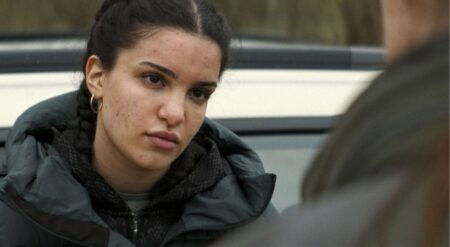Full Bloom is an HBO Max original, now known as Max, floristry competition show by Eureka Productions hosted by celebrity florists Simon Lycett, Elizabeth Cronin, and Maurice Harris. The show’s eight episodes see ten florists competing for a grand prize through two types of contests: short individual designs with a specific flower at its center and team contests to create massive floral sculptures.
The structure of Full Bloom‘s competition is both a blessing and a curse. It distinguishes itself from this year’s other floral competition show, The Big Flower Fight on Netflix, which saw teams of two competing in one large sculpture event each episode. But it’s also a curse. With so much of each episode dedicated to the team contests, you neither have time to get to know the individual artists, their skills, nor their personalities. Additionally, the team aspect adds an awkward dynamic that feels foreign to the nature of forestry work.
There is a lot to enjoy in Full Bloom. The themes of each contest are unique and deliver exciting results. The music and set are mostly enjoyable, and the hosts are dynamic and different from one another. I especially appreciate that throughout each episode, the hosts will do short demonstrations for the viewers about simple floristry techniques that can enhance their own flowers at home. I like how they are as emotive about what they are judging as the contestants are about their creations. Maurice can be a bit too harsh for me sometimes, but that’s more on me than anything.
Unfortunately, there are a lot of aspects that feel like they don’t work. The way each episode works is that the first and second place winners of the individual contests are made team leaders on the large-scale team contest in the second two-thirds of the show. As much as it’s entertaining and beautiful to watch the huge constructions happen, they also leave a lot to be desired from a television perspective.
For one, this format makes it very difficult to get to know any of the contestants. Because so much time is just spent watching them work together and build these huge constructions, from mock shop windows to towering Van Gough recreations, you spend only a fraction of the amount of time with the individual contestants as you would in other shows. This format also leads to an uncomfortable system for eliminating competitors.
Each episode declares a winning team, all members of which are secure for that day. The losing team’s leader then must tell the judges whom they believe was their weakest link to help them decide who should leave. I get that this is a reality competition show, but putting the onus of deciding who to eliminate on the team leaders feels wrong. It seems to be done in part because these team contests are so large it’s hard to tell who contributes how. Or as some contrived means of bypassing showing actual footage of individual contributions since the 45-minute runtime and potentially limited camera crew makes it hard for the viewer to understand.
But regardless, it feels like an aspect that just shouldn’t matter in a floristry competition. While florists certainly work with teams and possibly even contractors with whom they are not familiar, taking individual florists and judging them on their leadership skills and their teammates’ fleeting opinion just feels unfair. And this seemingly reflects itself in the way some of the contestants respond to their being eliminated. I love that Full Bloom tried something different in their structure, but unfortunately, this aspect withers for me every time the team leaders are called upon to judge their teammates. My favorite part about these types of light-hearted reality competition shows is the relationship between the contestants. I just want them to all be friends when the season is over. This show has me fearing these folks will never want to talk to each other again.
Yet, there are so many little tiny moments where you can see the competitors making inside jokes with one another or showing true comradery. I wish Full Bloom took more time to show these moments between the participants, working well together and enjoying themselves, rather than only focusing on the negative moments.
I appreciate that at the end of each episode, the flowers used on the show are donated to local front line workers to enjoy. They show hospital staff, grocery store workers, and others enjoying these flowers and expressing their gratitude, and it feels great for two reasons. For one, floristry can be a massively unsustainable industry, and I spent the whole first episode deeply hopeful that the show would donate these flowers. I was so glad when they showed the donations during the credits. Secondly, the show was produced during COVID, and so acknowledging the real world going on around this production, especially by making life just a little bit brighter for people who are risking their lives every day, is excellent.
The individual contests feel too small, and the team contests feel too big, but regardless of my complaints, Full Bloom is still an enjoyable show to watch. It’s low-stakes, pretty, and features competitors, hosts, and guests who are plenty entertaining and gripping.
Full Bloom is streaming on Max, formally known as HBO Max.
Full Bloom
-
Rating - 7/107/10
TL;DR
The individual contests feel too small, and the team contests feel too big, but regardless of my complaints, Full Bloom is still an enjoyable show to watch. It’s low-stakes, pretty, and features competitors, hosts, and guests who are plenty entertaining and gripping.







